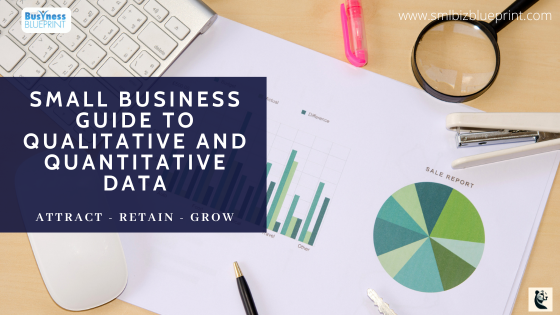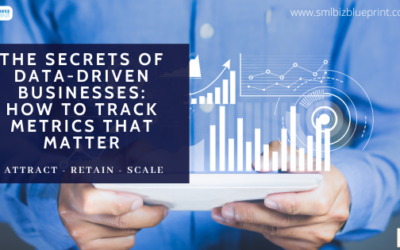In today’s data-driven world, the ability to harness and interpret various types of data can significantly enhance small businesses’ decision-making processes and competitive edge.
Qualitative and quantitative data each play distinct and crucial roles in these dynamics.
While 73% of organisations believe investing in big data is essential for staying competitive, many small businesses struggle to integrate these powerful tools into their operations effectively.
This post delves into the art and science of using qualitative and quantitative data to survive and thrive in the marketplace.
It will guide you through understanding qualitative and quantitative data, how they differ, and when each should be employed to maximise their benefits.
From gathering rich, narrative-driven qualitative insights to leveraging precise, numerical quantitative facts, we’ll explore how these data types can provide a comprehensive picture of your business landscape.
Whether you want to refine your marketing strategy, enhance customer engagement, or streamline operations, mastering these data forms will empower you to make more informed, effective business decisions.
Let’s examine how small businesses can collect and strategically use this information to push the boundaries of what they can achieve.

#1 Introduction to Data-Driven Decision-Making
Every decision in small businesses can significantly impact the bottom line. In this digital age, where data is more accessible than ever, embracing data-driven decision-making is not just an advantage—it’s a necessity.
A staggering 73% of businesses have no less than recognised the need for big data, underscoring its importance across industries (Forbes).
Embracing the Power of Data
Data-driven decision-making involves making choices based on data analysis rather than intuition or observation alone. This approach streamlines operations and enhances customer interactions and strategic planning for small businesses.
Whether you’re refining your marketing campaigns, optimising your product offerings, or improving customer service, data provides the factual basis for your decisions.
Objective of This Exploration
This blog post aims to unpack the dual facets of data essential for small businesses: qualitative and quantitative data. Each type serves unique purposes and provides different insights.
By understanding both, small business owners can gain a more holistic view of their business environment, leading to more informed and effective decision-making.
What to Expect
As we delve deeper into the topic, this article will guide you through:
The definitions and distinctions between qualitative and quantitative data.
Practical advice on when and how to leverage each type of data.
Real-world applications and strategies that demonstrate the integration of qualitative and quantitative insights for business growth.
By the end of this exploration, you will be equipped with the knowledge and tools to harness the full potential of data to navigate and excel in the competitive business landscape.
This foundational understanding sets the stage for the detailed exploration of both data types in the following sections, ensuring that your approach to data-driven decision-making is strategic and comprehensive.
#2 Understanding Qualitative Data: What It Is and When to Use It
Qualitative data can be considered the colour and context behind the hard numbers of quantitative data. This type of data is descriptive in nature and provides insights into the why and how behind patterns observed in numerical data.
From customer interviews to open-ended survey responses, qualitative data enriches your understanding by adding layers of depth to the information gathered.
Defining Qualitative Data
Qualitative data involves non-numerical information that helps business owners understand underlying reasons, opinions, and motivations. It’s gathered through methods such as interviews, focus groups, and observations—techniques that allow for in-depth responses and discussions.
This data is inherently subjective and can vary significantly depending on the individual providing the information.
Examples of Qualitative Data in Small Business
- Customer Feedback: Direct comments from customers about a product or service that highlight how they feel and what they value.
- Focus Groups: Discussions among a small group of people about their perceptions and experiences with a product, service, or advertisement.
- Observational Notes: Insights gained from watching how customers interact with products in a store or within a user testing environment.
When to Use Qualitative Data
Qualitative data is particularly useful when:
- Exploring New Concepts: Gathering qualitative insights can help understand potential customer reactions and needs before launching a new product or service.
- Improving Products or Services: Feedback from users can pinpoint specific areas of improvement that might not be evident through quantitative data alone.
- Building Customer Personas: In-depth interviews and focus groups help create detailed customer personas, giving your target market a face and a story.
Benefits of Qualitative Data for Small Businesses
The richness of qualitative data lies in its ability to provide context and meaning that quantitative data cannot fully convey.
It helps small business owners:
- Understand the Emotional Drivers: Knowing what motivates customers can help tailor marketing strategies and product offerings more effectively.
- Identify Trends: Qualitative data can reveal customer thoughts and behaviour trends, offering early insights into shifting market dynamics.
- Enhance Customer Engagement: By understanding the nuances of customer needs and expectations, businesses can enhance their engagement strategies, leading to better customer retention and loyalty.
Qualitative data offers small businesses a narrative-rich avenue to glean actionable insights. Its integration into your data-driven decision-making processes ensures that your strategies are informed by what your customers do and why they do it.
As we transition into quantitative data in the next section, remember how both types of data complement each other to provide a fuller picture of your business landscape.
#3 Exploring Quantitative Data: Definitions and Benefits for Small Businesses
While qualitative data offers depth, quantitative data provides the breadth and scale necessary for measuring and tracking performance.
Quantitative data is all about the numbers—providing measurable, objective data that can be used to make informed business decisions.
It is essential for any small business looking to scale operations or simply measure its current standing accurately.
What is Quantitative Data?
Quantitative data is numerical information that can be measured and analysed statistically. It is crucial for any quantitative analysis in business, as it offers clear metrics and tangible evidence to support business decisions.
It is typically collected through methods such as surveys, analytics platforms, and other tools that can quantify information.
Examples of Quantitative Data in Small Business
- Sales Figures: Daily, monthly, or annual sales data help track performance and identify trends over time.
- Website Traffic: Data collected from web analytics tools like Google Analytics provides insights into the number of visitors, page views, and user journeys on your site.
- Customer Demographics: Information such as age, gender, and location gathered through customer purchases or sign-ups can be crucial for targeted marketing campaigns.
When to Use Quantitative Data
Quantitative data is particularly useful when:
- Setting and Measuring Goals: Clear numerical targets allow businesses to set specific goals and measure their progress accurately.
- Evaluating Business Health: Financial figures, sales data, and other metrics provide a snapshot of the business’s financial health.
- Making Predictions: Businesses can forecast future trends, from sales peaks to potential downturns, using past numerical data.
Advantages of Quantitative Data for Small Businesses
The concrete nature of quantitative data provides several benefits:
- Objectivity: The data is not subject to personal feelings or interpretations, which makes it reliable for making critical business decisions.
- Ease of Analysis: Various statistical tools and software are available, so quantitative data can be quickly analysed to produce actionable insights.
- Scalability: Quantitative data analysis can easily scale as the business grows, handling larger datasets without losing accuracy.
Integrating quantitative data into regular operations is not just a best practice for small businesses—it’s a cornerstone of sustainable growth. By systematically tracking key performance indicators (KPIs), small business owners can make data-driven decisions that align with their strategic goals.
In the following sections, we will explore the methods for collecting this data and the tools to enhance its analysis, ensuring that you can harness its full potential to your business’s advantage.

#4 Methods for Collecting Qualitative Insights
For small businesses, the ability to collect and interpret qualitative data can unlock profound insights into customer behaviours, preferences, and experiences.
This section explores various methods for gathering qualitative insights, which can greatly enhance how you understand and interact with your market.
Techniques for Gathering Qualitative Data
Customer Interviews
One-on-one interviews provide deep insights into the customer’s thoughts and feelings.
Structured as open-ended conversations, these interviews can reveal underlying motivations and dissatisfaction points that are not visible through quantitative methods.
Focus Groups
Bringing together a small group of people to discuss their views on a product, service, or concept allows for a dynamic exchange of ideas.
Observing interactions can also provide additional insights that individual interviews may not capture.
Observations
Watching how people interact with your products or services in their natural environment (such as in-store or during a service operation) can yield unsolicited insights that surveys might miss.
Tools to Assist in Qualitative Data Collection
Digital Recorders: These are used to capture every detail during customer interviews and focus groups without relying on note-taking.
Video Conferencing Software: Tools like Zoom or Skype can facilitate remote interviews and focus groups, expanding your reach to a wider demographic.
Qualitative Analysis Software: Tools like NVivo or ATLAS help code and analyze textual data from interviews and focus groups, making identifying common themes and patterns easier.
Best Practices for Collecting Qualitative Data
Ensure Diversity in Your Sample: To avoid biased results, include participants from various demographics and backgrounds.
Create a Comfortable Environment: Whether it’s an in-person interview or a digital focus group, ensure participants feel safe and comfortable to share honest feedback.
Ask Open-Ended Questions: Avoid yes/no questions to encourage discussion and detailed responses. Instead, use prompts like “Can you explain more about…” or “What do you feel about…”
Ethical Considerations
Collecting qualitative data often involves gathering sensitive information. It’s crucial to:
Maintain Confidentiality: Assure participants their responses will be anonymised or kept confidential.
Obtain Consent: Always inform participants about the purpose of the study and obtain their consent before collecting data.
Leveraging Qualitative Insights
Once collected, qualitative data needs to be carefully analysed to extract meaningful insights. These insights can inform product development, marketing strategies, and customer service enhancements, directly impacting your business’s growth and customer satisfaction.
By mastering these methods, small businesses can gain a competitive edge by truly understanding what drives their customers.
In the next section, we will explore how quantitative data complements these insights by providing a scalable and objective measure of business performance.
#5 Analyzing Quantitative Data: Tools and Techniques
Quantitative data analysis is pivotal for small businesses, as it transforms raw numbers into actionable insights.
This section will guide you through the tools and techniques essential for effective analysis, ensuring you can reliably measure and enhance your business performance.
Essential Tools for Quantitative Data Analysis
Excel
A fundamental tool for any small business, Excel allows for creating spreadsheets where data can be organised, analysed, and visualised. Functions like pivot tables, formulas, and chart tools are invaluable for basic analyses.
Google Analytics
This tool is crucial for understanding web traffic, user behaviour, and conversion metrics. Google Analytics helps small businesses optimise their online presence by providing detailed insights into how users interact with their websites.
Business Intelligence Software
Platforms like Tableau or Power BI offer advanced data visualisation and analysis capabilities. These tools can handle larger datasets and provide more sophisticated insights than Excel.
Techniques for Quantitative Data Analysis
Descriptive Statistics: Start with basic statistics such as mean, median, mode, and standard deviation to understand the distribution and central tendencies of your data.
Trend Analysis: Identify patterns, such as seasonal sales or website traffic variations over time. This can inform decision-making related to inventory management or promotional strategies.
Correlation Analysis: This method determines relationships between different variables, which can help understand what factors influence customer behaviour or sales performance.
Interpreting the Data
Interpreting quantitative data involves more than just reading numbers off charts. It requires understanding the context:
Contextual Analysis: Align data insights with business goals and market conditions. If sales drop in a particular month, consider external factors like economic downturns or changes in consumer behaviour before making strategic decisions.
Comparative Analysis: Compare your data with industry benchmarks or historical performance to gauge your business’s performance and identify areas for improvement.
AI Tools for Enhanced Data Analysis
Automated Analytics: Embrace the power of AI-driven tools like IBM Watson Analytics, which simplify the analysis of large data sets by automating data processing and visualisation.
These tools can identify patterns and trends that might not be immediately obvious, enabling small businesses to make data-driven decisions quickly and efficiently.
Predictive Analytics: AI’s ability to leverage vast amounts of historical data allows for predictive analytics, offering forecasts that help businesses prepare for future trends.
This could range from predicting customer buying behaviours to anticipating seasonal fluctuations in sales, giving small businesses a strategic advantage in planning and resource allocation.
Best Practices for Effective Data Analysis
- Regular Data Review: Schedule regular reviews of your quantitative data to stay updated on business performance and react quickly to any emerging trends or issues.
- Employee Training: Equip your team with basic data literacy skills to help them understand and effectively use business data in their roles.
- Quality Data Collection: Ensure that your data is accurate and relevant.
Poor quality data can lead to misguided insights and decisions.
For small businesses, quantitative data provides a clear and objective measure of their current and future needs. By effectively analysing this data, you can set realistic goals, forecast future trends, and make informed decisions that drive business growth.
In the next sections, we will explore how combining quantitative data with qualitative insights can provide a more comprehensive understanding of your business environment.
#6 Combining Qualitative and Quantitative Data for Comprehensive Insights
Understanding both qualitative and quantitative data separately is valuable, but integrating these two can transform your business insights into actionable strategies.
This section explores how blending these data types helps small businesses make balanced, informed decisions that consider both the measurable outcomes and the underlying human factors.
The Benefits of Data Integration
Integrating qualitative and quantitative data allows businesses to:
Enhance Validation: Use qualitative insights to explain the ‘why’ behind the ‘what’ that quantitative data reveals. For example, if sales data indicates a decline, customer interviews might uncover that it’s due to a perceived decrease in product quality.
Create Fuller Customer Profiles: Combine statistical data with personal feedback to develop more comprehensive customer personas, which can inform more targeted marketing strategies.
Improve Product Development: Quantitative data might show which features are used most. In contrast, qualitative data can provide insights into how customers feel about these features and what they might be missing.
Methods for Integrating Qualitative and Quantitative Data
Sequential Approach: Start with qualitative data to explore ideas and hypotheses, and then use quantitative data to test these hypotheses on a larger scale.
Concurrent Approach: Collect and analyse both data types simultaneously to gain a more rounded view of an issue, which can lead to deeper insights and more robust conclusions.
Iterative Approach: Use an ongoing process in which initial quantitative data informs qualitative research, and the insights gained there can lead to further quantitative analysis.
Examples
Retail: A clothing retailer noticed a decline in online sales (quantitative). Through customer surveys (qualitative), they discovered that the issue was a complicated checkout process. Simplifying the process led to an immediate increase in sales.
Service Industry: A restaurant chain used customer satisfaction scores (quantitative) alongside diner reviews (qualitative) to redesign its menu, enhancing dishes that received both high scores and positive comments.
Strategies for Effective Data Integration
Use Software Tools
To streamline the integration process, use tools, such as mixed-methods research software, that can handle both data types.
Cross-Functional Teams
Encourage collaboration between different departments (e.g., marketing for qualitative insights and finance for quantitative data) to ensure a holistic approach to data analysis.
Training and Development
Invest in training for your team to understand both data types and how to integrate them effectively.
Mastering the art of combining qualitative and quantitative data is crucial for small businesses seeking a competitive edge.
This integrated approach not only enriches the understanding of your business landscape but also empowers you to make decisions that are both data-driven and deeply informed by customer insights.
Leveraging AI for Data Integration
Sentiment Analysis
AI technologies can perform sentiment analysis on qualitative data such as customer reviews and social media comments. By quantifying emotions and opinions, AI helps integrate these insights with quantitative data, such as sales figures, to provide a fuller picture of customer satisfaction and product performance.
Machine Learning Models
Utilise machine learning models to analyse combined data sets. These models can learn from both numerical trends and textual feedback to optimise product offerings, adjust pricing strategies, and tailor marketing messages, ensuring that strategies are as informed as possible.
In the following section, we will examine real-life applications demonstrating the power of a dual-data approach.

#7 Qualitative and Quantitative Data in Action
Implementing both qualitative and quantitative data can dramatically enhance decision-making processes in small businesses.
This section showcases real-life applications illustrating how integrating these data types leads to tangible improvements and strategic success.
Business Scenarios and Their Solutions
Scenario 1: Product Development in a Tech Startup
- Quantitative Insight: Usage data showed that 30% of users dropped off after the initial login.
- Qualitative Insight: Follow-up interviews revealed that users felt overwhelmed by the interface.
- Solution: Simplify the interface based on specific feedback, leading to a 15% increase in user retention.
Scenario 2: Customer Service Enhancement in Retail
- Quantitative Insight: Customer feedback scores were consistently low for one particular store.
- Qualitative Insight: Employee focus groups indicated a lack of training and morale.
- Solution: Implement a new training program and schedule regular team-building sessions, improving service scores by 20%.
Applications
A Local Bakery Expands Its Market
- Quantitative Analysis: Sales data identified that 40% of the bakery’s revenue came from specialty cakes.
- Qualitative Feedback: Customer surveys expressed high satisfaction with these cakes, highlighting the desire for more customisation options.
- Outcome: The bakery introduced an online cake customisation tool, leading to a 25% increase in specialty cake sales within six months.
Improving Patient Care in a Small Clinic
- Quantitative Data: Patient revisit rates were declining.
- Qualitative Data: Patient interviews highlighted waiting times and appointment scheduling as major frustrations.
- Initiative: The clinic introduced an online scheduling system and optimised appointment timings, which improved patient revisit rates by 30%.
AI Success Stories in Data Application
Retail AI Applications
Consider a retail business implementing AI to analyse customer feedback and sales data. The AI system identified that customers were particularly pleased with a product feature that was not heavily marketed. By reallocating marketing resources to highlight this feature, the business saw a significant increase in sales.
Customer Service AI
A service-oriented business might deploy AI chatbots that analyse both customer queries (qualitative data) and transaction history (quantitative data). These chatbots can provide personalised service and product recommendations, improving customer satisfaction and increasing sales through personalised upselling.
Lessons Learned
From these examples, small businesses can extract several key lessons:
- Customer-Centric Approaches: When combined with behavioural data, customers’ feedback can pinpoint areas for immediate improvement.
- Employee Insights Matter: Internal feedback is as valuable as external data, providing critical insights that affect customer experience.
- Agile Response to Data: The ability to quickly adapt based on integrated data insights can significantly enhance business operations and customer satisfaction.
Integrating qualitative and quantitative data provides a comprehensive view of business operations and highlights the importance of understanding the story behind the numbers.
For small businesses, this approach involves collecting data and transforming it into actionable strategies that drive growth and success.
The next section will explore data analysis challenges and provide solutions to help small businesses leverage their full potential.
#8 Challenges and Solutions in Data Analysis for Small Businesses
While integrating qualitative and quantitative data can provide invaluable insights for small businesses, the process is challenging.
This section discusses common hurdles small businesses may encounter in their data analysis efforts and provides practical solutions to overcome them.
Common Challenges in Data Analysis
Limited Resources
Many small businesses operate with constrained budgets and may lack the financial resources to invest in advanced data analysis tools or hire specialised personnel.
Data Quality and Collection Issues
Small businesses often struggle with collecting high-quality data. Inadequate data collection methods can lead to incomplete data sets or data that doesn’t accurately represent the target metrics.
Lack of Expertise
Data analysis requires a certain level of expertise, and small business owners often wear many hats, which may not include data scientists.
Solutions to Enhance Data Analysis
Addressing Limited Resources
Use Free or Low-Cost Tools: Tools like Google Analytics for web data or Microsoft Excel for basic data analysis provide powerful functionalities at minimal or no cost.
Outsource When Necessary: For complex data projects, consider outsourcing to freelance data analysts who can provide expertise at a lower cost than full-time hires.
Improving Data Quality and Collection
Standardise Data Collection Methods: Develop clear protocols for collecting and storing data. Regular training sessions for staff involved in data collection can also improve the data quality.
Leverage Customer Interactions: Every customer interaction is an opportunity to gather data. Simple tools like customer feedback forms or email surveys can be effective and inexpensive.
Overcoming Lack of Expertise
Educational Resources: Take advantage of online courses and workshops designed to enhance data literacy. Websites like Coursera and Khan Academy offer courses on data analysis and related topics.
Collaborative Tools: Use cloud-based tools that allow for easy sharing and collaboration, enabling you to leverage insights from all team members, regardless of their location.
Ethical Considerations in Data Handling
Handling data responsibly is crucial, particularly when dealing with sensitive customer information.
Ensure Data Privacy
Comply with data protection regulations such as GDPR or CCPA to protect your customers’ information.
Transparent Data Use
Be transparent with your customers about how their data is being used. This not only builds trust but also ensures compliance with legal standards.
Strategic planning and smart utilization of available resources can help small businesses face these challenges head-on and significantly improve the effectiveness of data analysis.
Preparing for AI Implementation
AI Readiness
Small businesses should assess their readiness for AI by evaluating their current data collection and analysis practices, ensuring they have the necessary data infrastructure, and identifying key areas where AI can benefit most.
Training staff to handle AI tools and interpret their output is also crucial.
Ethical AI Use
It’s important to approach AI integration with a commitment to ethics. Ensure that AI systems are transparent in making decisions and comply with relevant data protection laws.
Mitigating biases in AI algorithms is also crucial to prevent skewed outcomes that could lead to unfair or harmful business practices.
By implementing these solutions, small businesses can better navigate the complexities of data analysis, leading to more informed decisions and greater business success.
Our final section will recap the best practices for leveraging qualitative and quantitative data to drive impactful business strategies.
Conclusion
As we wrap up our exploration of how small businesses can effectively use qualitative and quantitative data, the power of data-driven decision-making cannot be overstated.
Integrating both types of data enhances the accuracy of your insights and provides a holistic view of your business environment, enabling you to make informed and strategic decisions.
Here, we summarise the best practices and key takeaways to ensure that small businesses can maximise the benefits of their data analysis efforts.
Recap of Key Points
Understand Each Data Type: Recognize the unique advantages of both qualitative and quantitative data. Qualitative data offers depth and context, helping you understand the “why” behind customer behaviours, while quantitative data provides the scalability and objectivity needed to measure performance and outcomes effectively.
Integrate Data for Comprehensive Insights: Use qualitative data to inform and enhance the interpretation of quantitative data and vice versa. This integration allows for more nuanced strategies that address both the numerical trends and the underlying customer sentiments.
Leverage Appropriate Tools: Opt for tools that match your business’s needs and budget. From simple spreadsheet software like Excel to more sophisticated analytics platforms like Google Analytics and Tableau, choose tools that you can use effectively to gather, analyze, and interpret data.
Implement Regular Data Reviews: Establish a routine for regular data analysis to stay proactive rather than reactive. Monitoring data trends helps quickly identify and respond to changes in customer behaviour or market conditions.
Educate and Train Your Team: Encourage a culture of data literacy within your organisation. Training employees to understand and use data effectively ensures that everyone can contribute to the dialogue and decisions driven by data insights.
Maintain Ethical Standards: Always prioritise the privacy and security of the data you collect. Adhering to data protection laws and maintaining transparency with your customers about how their data is used builds trust and safeguards your business against legal issues.
If you’re new to data analysis, start small. Integrate data-driven decisions into one aspect of your business, such as marketing or customer service, and gradually expand as you gain confidence and expertise.
Remember, the goal is not to collect the most data but rather to collect the right data and use it wisely.
Further Resources
For those looking to deepen their understanding of data analysis, consider the following resources:
- Online courses on platforms like Coursera or Udemy that offer specialised training in data analytics.
- Books such as “Naked Statistics” by Charles Wheelan for a layperson’s introduction to the power of statistical thinking.
- Industry blogs and publications that provide updates on the latest tools and trends in data analysis.
By adhering to these best practices, small businesses can harness the transformative power of qualitative and quantitative data.
The insights derived from these data drive smarter business decisions, enhance customer relationships, and improve operational efficiency, positioning your business for success in an increasingly competitive marketplace.
FAQs
Q1 What is the difference between qualitative and quantitative data?
A1: Qualitative data is descriptive and provides insights into customer behaviours’ underlying reasons and motivations. It is often gathered through interviews, focus groups, and observations. On the other hand, quantitative data is numerical and used to measure and analyse statistical information, such as sales figures, website traffic, and customer demographics.
Q2 How can small businesses effectively collect qualitative data?
A2: Small businesses can collect qualitative data through methods such as customer interviews, focus groups, observational studies, and open-ended survey questions. Tools like digital recorders, video conferencing, and qualitative analysis software can help streamline the data collection and analysis process.
Q3. What are the best tools for analysing quantitative data?
A3: Some of the best tools for analysing quantitative data include Excel for basic data manipulation and visualisation, Google Analytics for web traffic analysis, and business intelligence software like Tableau or Power BI for advanced data visualisation and analysis. These tools help businesses to interpret large data sets and derive actionable insights.
Q4. How can AI improve data analysis for small businesses?
A4: AI can enhance data analysis by automating data processing, performing predictive analytics, and integrating qualitative and quantitative data. Tools like IBM Watson Analytics can provide deeper insights faster, while AI-driven sentiment analysis can quantify customer feedback, helping businesses understand customer emotions and improve their strategies.
Q5. Why is it important to integrate qualitative and quantitative data?
A5: Integrating qualitative and quantitative data provides a more comprehensive understanding of business performance and customer behaviour. While quantitative data offers measurable insights and trends, qualitative data adds context and depth, helping businesses to understand the reasons behind the numbers and make more informed decisions.
Q6. What are some common challenges in data analysis for small businesses, and how can they be addressed?
A6: Common challenges include limited resources, data quality issues, and lack of expertise. Solutions include using free or low-cost tools for analysis, standardising data collection methods, leveraging customer interactions for data, outsourcing to experts when necessary, and investing in employee training to build data literacy.
Q7. How can small businesses ensure they are using AI ethically?
A7: To use AI ethically, small businesses should ensure transparency in AI decision-making processes, comply with data protection regulations, and mitigate biases in AI algorithms. It’s important to be transparent with customers about how their data is used and to prioritise data privacy and security to build trust and protect sensitive information.
Other Articles
Understanding Data: A Basic Guide for Small Business Owners
Unlock Big Results: 5 Simple CRO Strategies for Small Businesses
Mastering Lead Scoring: Best Practices and Strategies for Small Business Success




